- Home
- Carl Sagan
Comet Page 15
Comet Read online
Page 15
The light given off by a comet enters a telescope and passes through a prism (rear), where its constituent frequencies are untangled, and a rainbow spectrum of visible light is produced. The five colors shown schematically here—each representing a different frequency or color of light—correspond to five prominent emission bands of C2—the molecule composed of two carbon atoms, symbolized at bottom. In addition, cometary spectra show emission bands of other molecules, and the characteristic absorption features of the sunlight they reflect. Diagram by Jon Lomberg/BPS.
When a spectrometer of higher dispersion was used, it was found that sunlight was composed, in addition to its rainbow continuum, of a set of irregularly spaced dark lines, representing missing frequencies. It was soon determined that these lines were produced when light from the hotter, deeper layers of the Sun is absorbed by a cooler higher atmosphere of gas surrounding the Sun. Each chemical element absorbs a different set of frequencies and produces a different set of dark lines. In the laboratory, when a spectrum of a mix of chemical elements (and simple molecules) was obtained, the dark lines of all the constituent atoms would be seen. Soon it became possible to identify some of the spectral lines in sunlight, by comparison with laboratory experiments on the absorption spectra of common materials on Earth.
Each chemical element leaves its own unique signature in the spectrum. You could accumulate a catalogue of such signatures and then recognize in the spectrum of the Sun evidence of its constituent atoms. Scientists found themselves, to their own astonishment, measuring the constitution of the Sun and stars. Spectroscopy revolutionized the science of the time, and astronomy most of all.
Huggins was the beneficiary of a spectroscopic technology just reaching maturity. He put his spectrometer at the focus of large telescopes and looked at everything he could. He was the first to show that the stars were made of the same chemical elements as the Earth and the Sun. He proved Edmond Halley’s conjecture that certain interstellar nebulae were vast clouds of glowing gas. When Comet Winnecke passed near the Earth in 1868, it was a matter of course for Huggins to examine the spectrum of its coma. He confirmed a finding made for another comet by Donati in 1864 that there were three bright bands in the blue part of the cometary spectrum. Huggins also found that, in the spectra of the comets there were two components—a continuum of color interspersed with dark absorption lines that he correctly guessed was merely reflected sunlight, and the three bright bands that had been seen by Donati. If a dark line meant that some atom or molecule was absorbing light, then a bright line, or a set of them, meant that something was emitting light. But what?
The only way to answer this question was to look at the emission spectra of a wide variety of materials in the laboratory. In 1868 Huggins made a surprising discovery. He sparked ethylene (C2H4)—something like the natural gas used in household ovens—examined it in the spectrometer, and found exactly the same three bright bands as had been detected in emission from the comets. He concluded:
There could be no longer any doubt of the oneness of chemical nature of the cometary stuff with the gas we were using, in fact, that carbon, in some form or in some state of combination, existed in the cometary matter.
The three bright bands are now known to be produced by the molecular fragment C2, two carbon atoms bonded together. It is produced when you pass a spark through C2H4 and break the molecule apart.
When the Great Comet of 1881 appeared, Huggins again obtained a spectrum, in which we can today recognize not only the presence of C2, but also C3, CH, and CN—a rich harvest from the first cometary spectrum to be photographed. (Huggins himself essentially identified C2, CN, and argued for hydrocarbons of which the molecular fragment CH is the simplest exemplar.) We now know that it is hard to find a comet without the spectral features of C2, C3, and CN in their comas. Huggins was struck by the fact that the material in the comets was similar to organic matter of unquestioned biological origin on Earth. Many scientists cautiously concluded that the carbon compounds found by Huggins in the comas of comets were, as one of his contemporaries wrote, “the result of the decomposition of organic bodies.” Only rarely voiced explicitly was the key question: Were such “organic bodies” biological?
A cometary spectrum by William Huggins showing dark solar absorption lines (designated K, H, h, G, etc.) superimposed on three clusters of bright lines representing emission from the comet. From Proceedings of The Royal Institution, Volume 10.
These discoveries of Huggins and his successors interested virtually no one—until 1910, when it seemed the Earth was about to brush against the tail of Halley’s Comet. The molecular fragment CN, a carbon atom attached to a nitrogen atom, had by then been detected in the comas and tails of many comets, and then confirmed in Halley’s Comet as well. It was called cyanogen. But when chemically combined in a salt it had another name—cyanide. Since only a grain of potassium cyanide touched to the tongue is sufficient to kill an adult human, the idea of the Earth flying through a cloud of cyanide generated a certain apprehension. People imagined themselves choking, gasping, and dying, millions asphyxiated by the poison gas.
Nineteenth-century spectra of emission bands in (2) olive oil, (3) ethylene, and (4, 5) in a pair of comets. Comet Winnecke II seems to have more in common with olive oil than it does with Comet Brorsen I. All the comparison actually shows is that olive oil, ethylene, and cometary nuclei, when heated or irradiated, give off such molecules as C2. Diagram from Camille Flammarion, Astronomie Populaire (Paris, 1880).
The global pandemonium about poison gas in the tail of Halley’s Comet was, sadly, fueled by a few astronomers who should have known better. Camille Flammarion, a widely known popularizer of astronomy, raised the possibility that “the cyanogen gas would impregnate the atmosphere [of the Earth] and possibly snuff out all life on the planet.” With vaguely similar pronouncements by Gambart and Laplace preceding him, and a traditional dread of comets tracing back into prehistoric times, it is not surprising that statements like Flammarion’s helped to produce a worldwide comet frenzy.
In fact, it was not even clear that the Earth would pass within the tail of Halley’s Comet. In any case, the tails of comets are extraordinarily thin, a wisp of smoke in a vacuum. The cyanogen is in turn a minor constituent in the tails of comets. Even if the Earth had passed through the tail in 1910 and the molecules in the tail had been thoroughly mixed down to the surface of the Earth, there would have been only one molecule of cyanogen in every trillion molecules of air—a good deal less than the pollution caused even far from cities by industrial and automobile exhaust (and much less than what would happen in the burning of cities in a nuclear war). Also, the Earth had, half a century earlier, passed well into the tail of the Comet of 1861 with no apparent ill-effects.
A modem cometary spectrum. Comet Kobayashi-Berger-Milon shows prominent spectral features due to C2 and CN; the spectral signatures of other molecular fragments are also displayed. At bottom is a scale of wavelengths that runs through the visible spectrum. Observations from the Wise Observatory, Mitzpe Ramon, Israel. Courtesy National Aeronautics and Space Administration.
All this, or something like it, was made clear by the global astronomical community, but—like the 1979 worldwide anxiety that the Skylab satellite would fall on the heads of innocent passersby—the assurances had little effect. Why should the world population be so susceptible? This was certainly a time of burgeoning industrial pollution and attendant respiratory disease. But it also seems possible that the fear was not so much about poison gas up there in the comet as down here in the national arsenals. In H. G. Wells’ War of the Worlds (1898), Martians invading the Earth used chemical weapons. This was one of many novels of the period, depicting a future war, in which devastating poison gas attacks were vividly portrayed.
However, far from being merely the inventions of science fiction authors, these works reflected a dismaying reality. At least until a few years before the 1910 apparition of Halley’s Comet, new approaches to chemical war
fare were being actively pursued in European military establishments. At the Hague conference of 1899, proposals for banning certain chemical weapons were offered, but they were successfully opposed by John Hay, the American Secretary of State. A resolution forbidding asphyxiating gases in artillery shells was adopted, but the United States would not sign. When the First World War came, four years after the comet, 120,000 tons of poison gas were used, mainly by Germany, France, and to a lesser extent, the United States, producing one and a quarter million casualties. More than a quarter of all American casualties in World War I were due to poison gas. Only a small fraction of the poisons employed were cyanides.
But in 1910 the comet passed, no one was asphyxiated, and the Earth seemed none the worse for the experience. The most sensitive tests revealed not a trace of increased cyanogen in the air—a source of relief to many, although no comfort to the discoverer of cometary cyanogen. Less than a week before the closest approach of Halley’s Comet to the Earth, Sir William Huggins, the man who had frightened millions by minding his own business, died at eighty-six.
Since then, compelling evidence has emerged for the presence of frozen water and silicate minerals in addition to organics in the comets. But most of these simple molecules and molecular fragments are not present as such on the cometary nucleus; rather, they are bits and pieces of molecules, broken off the comet and released into space by radiation from the Sun. They were originally parts of larger, so-called parent molecules, whose identities are conjectured, but which remain largely unknown. More recent findings on cometary organic matter are described below.
In ordinary visible light, the spectra of comas tend to be dominated by the blue emission of C2. This molecule is unfamiliar because it breaks up or combines with other molecules upon collision. If you had some in the air before you, it would not last long. But in a comet coma or tail, the densities are so low that a long time will pass before C2 collides with another molecule. Imagine a C2 molecule sitting in space, exposed to radiation from the Sun. A photon of blue light hits it and raises it to what is called an excited state. It cannot get rid of this additional energy by collision, since there are no collisions. For a short while, it simply sits there in the coma, throbbing, until it does spit out a blue photon, but in a random direction. The C2 molecule has no memory of where the Sun is. As a result, blue frequency light from the Sun strikes the coma, and some of it that otherwise would be lost into space is reradiated back to Earth. The process is called fluorescence.
Accordingly, since the dust and ice in the comet reflect or scatter sunlight, there are two sources of light from the comet—scattered sunlight and fluorescence, both of which Newton anticipated. Other molecules may be much more weakly fluorescent, or may fluoresce in other wavelengths of light that are not so readily detectable from the surface of the Earth. So the prominence of certain molecules such as C2 in cometary spectra does not necessarily mean they are very abundant in comets. But their abundance is high enough to indicate that their parent molecules—carbon, or organic molecules—must be reasonably common in the cometary nucleus from which the coma derives. Much more common is the molecular fragment OH, produced by tearing water (HOH or H2O) apart.
Comets were not observed in the ultraviolet part of the spectrum until rocket and, later, orbiting observatories were aloft, above the Earth’s atmosphere, in the beginning of the 1970s. These first observations showed that comets have an envelope of hydrogen gas that extends for millions of kilometers from the cometary nucleus away from the Sun. Accompanying the hydrogen is OH, the two together evidently produced by the dissociation of water making up the cometary nucleus. The identification of ionized water, H2O+ (a water molecule with a negatively charged electron missing) in comets forges another link in the chain of evidence for water as a major constituent of the cometary nucleus. These results both qualitatively and quantitatively provide powerful additional support for Whipple’s dirty ice model of the cometary nucleus.
Subsequent ultraviolet observations by orbiting observatories, and by rockets specially fired above the Earth’s atmosphere for the purpose, have revealed a number of new molecules and molecular fragments—including S and CS, the first discovery of sulfur and its chemical products in comets. The most likely parent molecule of CS is CS2, and it in turn probably derives from more complex sulfur-containing organic molecules. In most cases the cometary spectra invite us to trace backward from simple molecular species that we can readily identify to progressively more complex and more uncertain parent molecules, among which may be complex organic molecules of the sort that are found in the interstellar grains and gas. Cometary methane (CH4), ethane (C2H6), and methyl alcohol (CH3OH) have since been discovered.
Infrared spectra of both the coma and the tail of comets (for example, Comet Kohoutek) show a spectroscopic emission feature due to silicates, the principal constituents of rocks. Beginning with observations of the Great September Comet (1882 II), the spectroscopic signatures of metals have been found in comets that come very close to the Sun. Such atoms as chromium, nickel, and copper, which are never observed in other comets, can be detected. The reason is clear: As Isaac Newton had first pointed out, sungrazers come so close to the Sun that even iron would become red hot. The individual mineral grains evaporate and boil, and a gas composed of metal atoms is poured off into the surrounding coma for astronomers on Earth to view. In the cold and dark from which the comets come, before their substance is boiled off by sunlight, the metals are probably chemically bound to the silicates and to oxygen.
Even for comets that never venture very near the Sun, the constituent dust grains and organic molecules find themselves in a kind of blast furnace during perihelion passage—compared to the staid and safe environment far from the Sun. High energy solar photons and charged particles are constantly bombarding cometary molecules, breaking them into pieces, tearing fragments off, ionizing, dissociating. Many of these molecules are so fragile that they last hours or less in the ultraviolet radiation of the Sun before they are torn apart. This is another reason that the molecules observed in comas and tails are not necessarily the most abundant molecules: what we see tends to be the molecules most resistant, most impervious to the radiation that bombards them.
Since methane ice (CH4) is expected to be abundant in the outer solar system, it is natural to consider it the parent molecule for such fragments as CH2. But unless a new vein of methane ice is by chance exposed just as the cometary nucleus enters the inner solar system, CH4 is unlikely at such high temperatures; and for this reason it is attractive to consider the methane trapped as a clathrate in the ice crystal lattice (Chapter 6). However, no amount of methane clathrate can explain such molecules as C2 and C3, which must derive from more complicated organics. Thus even the simplest cometary organic molecules such as CH may derive from more complicated organics and not from methane.
In addition to measurements in the visible, ultraviolet and infrared parts of the spectrum, there is also spectroscopy at radio frequencies. It does not use prisms and the like, but is perfectly able to distinguish absorption or emission lines due to particular atoms or molecules. So far as is known, the first attempt at radioastronomical observations of a comet was performed during the closest approach of Halley’s Comet to the Earth on May 18, 1910, by Lee De Forest, the inventor of the triode electron tube, a mainstay in the development of modern radio. With an aerial and his new receiver, he observed from the roof of a building in Seattle, Washington, and surmised—probably erroneously—that the comet was the source of the enhanced crackling static he thought he had detected. In our time, radio observatories have found abundant OH in comets, fragments expected from the breakup of water molecules. In addition, they have provided some evidence for cometary HCN (hydrogen cyanide) and CH3CN (acetonitrile), cyanides that may be parent molecules of the cyanogen that frightened millions in 1910.
In the 1970s radio spectroscopy opened a surprising new field when a variety of exotic molecules were found in interstellar spa
ce. You might, for example, be looking at some distant source of radio emission—the center of the Galaxy, say—and discover a range of new spectral lines produced by the diffuse gas between the radio source and your radio spectrometer. The gas between the stars is very thin, but if you can add up all the molecules in a line of sight thousands of light-years long, you might find even fairly rare molecules. The currently known interstellar molecules, most of them organic, are a chemical bonanza—apparently including the simplest amino acid.
Astronomers tend to be nervous about the word organic—concerned that it might be misunderstood as a token of life on another world. But “organic” only refers to molecules based on carbon. And organic chemicals would be produced and destroyed even if there were no life anywhere in the universe. Circumlocutions such as “carbonaceous” or “CHON” particles (after the constituent atoms) are in common use, but we will here employ the correct chemical term, organic. While organic chemistry does not in any sense imply biology, nevertheless, if there are complex organic molecules produced somewhere in the universe, it may well have some bearing on the question of life elsewhere, or even life down here on Earth. Indeed, the origin of life must have involved pre-existing organic molecules that by definition could not have been made by living things.

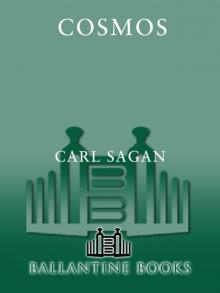 Cosmos
Cosmos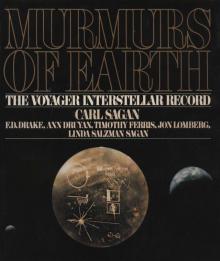 Murmurs of Earth
Murmurs of Earth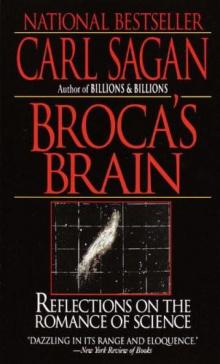 Broca's Brain
Broca's Brain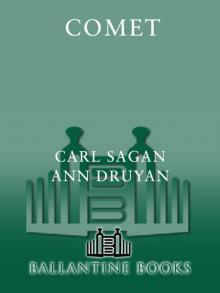 Comet
Comet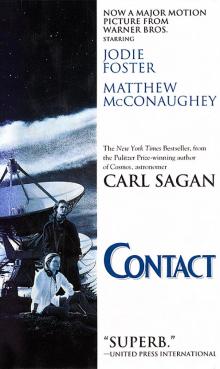 Contact
Contact Dragons of Eden
Dragons of Eden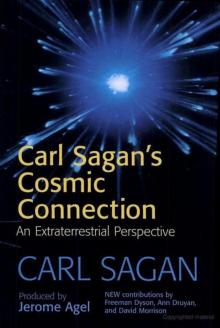 Cosmic Connection
Cosmic Connection Shadows of Forgotten Ancestors
Shadows of Forgotten Ancestors Billions & Billions
Billions & Billions Comet, Revised
Comet, Revised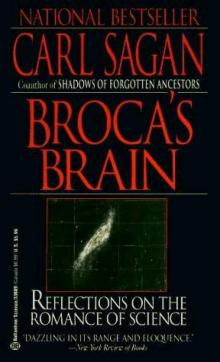 Broca's Brain: The Romance of Science
Broca's Brain: The Romance of Science The Varieties of Scientific Experience: A Personal View of the Search for God
The Varieties of Scientific Experience: A Personal View of the Search for God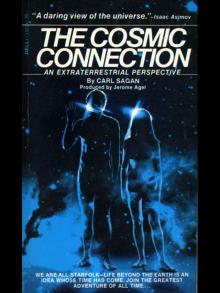 The Cosmic Connection
The Cosmic Connection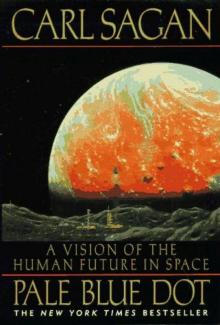 Pale Blue Dot: A Vision of the Human Future in Space
Pale Blue Dot: A Vision of the Human Future in Space The Dragons of Eden
The Dragons of Eden